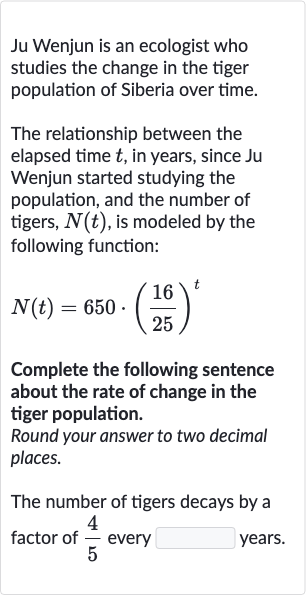AI tutor
Welcome to Bytelearn!
Let’s check out your problem:

Ju Wenjun is an ecologist who studies the change in the tiger population of Siberia over time.The relationship between the elapsed time , in years, since Ju Wenjun started studying the population, and the number of tigers, , is modeled by the following function:Complete the following sentence about the rate of change in the tiger population.Round your answer to two decimal places.The number of tigers decays by a factor of every years.
Full solution
Q. Ju Wenjun is an ecologist who studies the change in the tiger population of Siberia over time.The relationship between the elapsed time , in years, since Ju Wenjun started studying the population, and the number of tigers, , is modeled by the following function:Complete the following sentence about the rate of change in the tiger population.Round your answer to two decimal places.The number of tigers decays by a factor of every years.
- Given Function: We are given the function , which models the number of tigers over time. We want to find the time when the number of tigers decays by a factor of . This means we are looking for the time when is equal to .
- Set Up Equation: First, we need to set up the equation to solve for :
- Simplify Equation: We can simplify the equation by dividing both sides by :
- Use Logarithms: Now we need to solve for . Since both sides of the equation are powers of , we can use logarithms to solve for . We can take the natural logarithm () of both sides:\ln\left(\left(\frac{\(16\)}{\(25\)}\right)^t\right) = \ln\left(\frac{\(4\)}{\(5\)}\right)
- Apply Power Rule: Using the power rule of logarithms, we can bring down the exponent \(t:
- Solve for t: Now we can solve for by dividing both sides by :
- Calculate Value of t: We can now calculate the value of using a calculator:
- Round the Answer: We round the answer to two decimal places as instructed:
